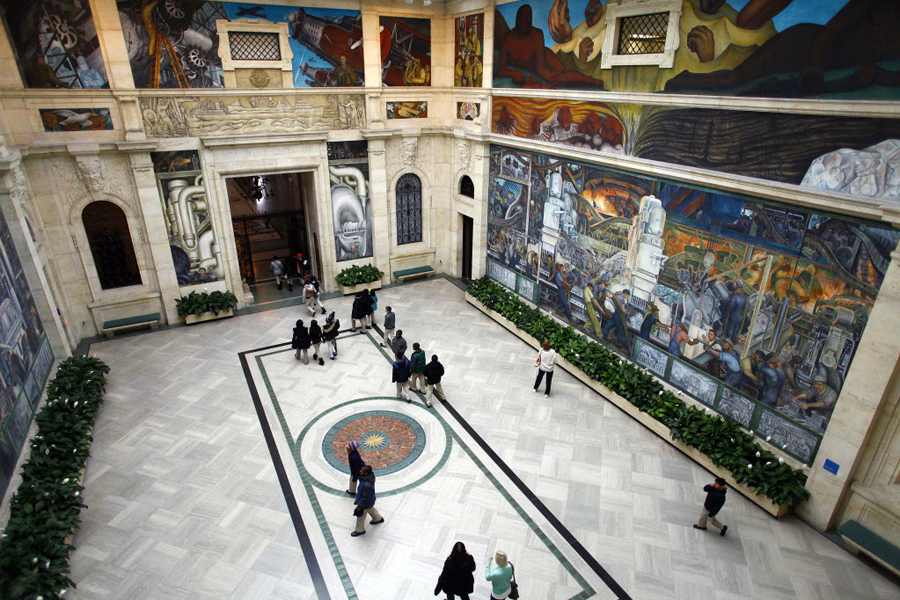Detroit bankruptcy: Creditors eye city’s art, but museum vows a fight
| Chicago
Ever since an emergency management team was dispatched to Detroit to restructure its ailing finances, one major asset has been under threat: hundreds of masterpieces housed at the Detroit Institute of Arts (DIA).
On Tuesday, a federal bankruptcy judge ruled for Detroit to proceed with a Chapter 9 restructuring, which will be the largest ever for a US municipality. He added, however, that the proceeds from the art museum, which he mentioned by name, may not be enough to satisfy the $18.5 billion in underfunded liabilities that the city must rectify.
The city “must take extreme care that the [museum collection] asset is truly necessary in carrying out its mission,” Judge Steven Rhodes said.
Creditors are resolute in saying the art is necessary to shore up cash because the collection, which includes at least 500 masterworks by Van Gogh, Rembrandt, and Matisse, is not vital to Detroit’s emergency services or the daily churn of city needs, such as lighting, sewers, and water.
Last week, a group of creditors filed a motion with Judge Rhodes asking him to appoint an independent committee to appraise the collection’s worth.
“We recognize that this is a very sensitive issue,” Derek Donnelly, managing director of the Financial Guaranty Insurance Co., a creditor, told the Detroit Free Press last week. “But at the same time, there needs to be a construct that addresses the fact that the DIA, or art, is not an essential asset and especially not one that is essential to the delivery of services in the city.”
The collection is already being appraised by Christie’s auction house in New York under the direction of Kevyn Orr, the emergency financial manager for Detroit. Creditors worry that the appraisal will come in too low. On Tuesday, Mr. Orr estimated that the most valuable pieces in the collection are worth less than $2 billion total – a figure that is four times less than what was estimated in media reports and among art insiders.
Christie’s is expected to release its appraisal as early as next week.
Douglas Bernstein, a bankruptcy attorney at Plunkett Cooney in Bloomfield Hills, Mich., says the motion filed by the creditor coalition is “premature” because it has yet to see a plan from Orr’s team, which is expected in early January. “They have no idea what the city is going to offer. I really don’t think they are going to get much traction, at least at this point, with this request,” Mr. Bernstein says.
Since his appointment in March by Michigan Gov. Rick Snyder (R), Orr has been relatively quiet about his plans for the DIA, which is considered to house one of the finest public art collections in the United States. However, he made his strongest statements on the matter Tuesday, telling the Free Press his team “will try to get some value from the art in some fashion.” He added, “Let’s be clear. That’s a city asset.”
Besides selling the art at auction, the city could monetize the collection by offering naming rights, lending pieces out for special use, and using certain pieces as collateral for loans.
Orr is suggesting that the DIA fight for its survival by immediately finding a way to monetize at least $500 million out of the collection, as a way to appease creditors during the mediation process. The museum is fighting that, saying it would actually threaten its existence by forcing valuable donors to flee and would jeopardize the tax millage it receives from a tri-county area.
“The DIA remains hopeful that [Orr] will recognize the City’s fiduciary duty to protect the museum art collection for future generations ...,” the museum said in a statement released Tuesday. “If the art is placed in jeopardy, the DIA remains committed to take action to preserve this cultural birthright for future generations.”
On the museum’s side is an opinion issued in June by Michigan Attorney General Bill Schuette. The art collection, he said, is protected by the public trust and therefore is immune to public sale or lease.
The opinion will probably help the DIA in court should it decide to sue the state, Bernstein says, but it may not “necessarily have traction” because Rhodes has the ultimate authority on the matter.
In his ruling Tuesday, Rhodes was cautious in suggesting that the DIA’s art would be enough to ultimately solve Detroit’s debt problems.
Bernstein says the judge “shares the sentiment of everyone who is not a pensioner or a creditor” – that over-reliance on DIA assets “wouldn’t be anything more than a band-aid fix, and the city has had enough band-aids that haven’t worked.”
“One of the major challenges for the city is ... it needs to market its product. The city has to sell itself: We have to attract an increased tax base or an increase in tourism,” he says. “And if you sell one of the things that brings people into the city, is the trade-off positive or negative?”






